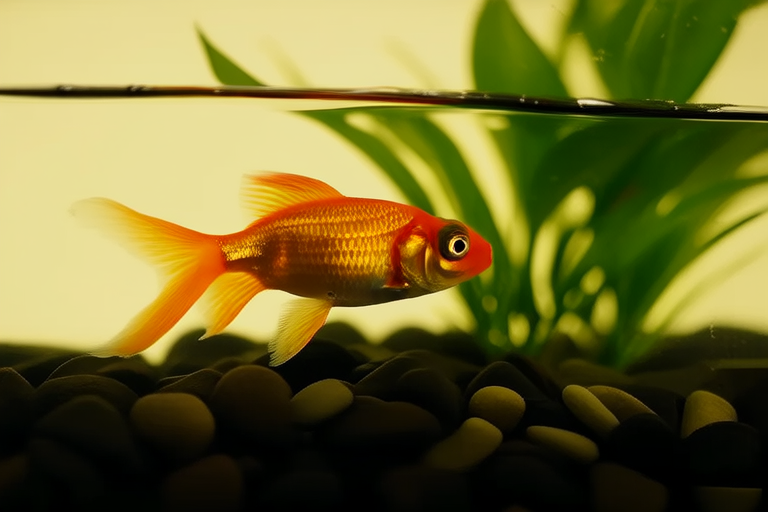How to Create the Perfect Habitat for Your Goldfish
Welcome to the wonderful world of goldfish keeping! These vibrant, friendly fish can bring joy and tranquility to your home. However, creating the perfect habitat for your goldfish requires careful planning and attention to detail. This guide will walk you through the essential steps to ensure your goldfish thrive in their aquatic environment.
Selecting the Right Tank Size
The first step in setting up your goldfish’s home is choosing the right tank size. Goldfish are active swimmers and grow quite large, so it’s crucial to provide ample space. A general rule of thumb is one gallon of water per inch of fish. For instance, if you plan to keep a single adult goldfish that grows to about six inches, you’ll need at least a 60-gallon tank. Smaller tanks can lead to poor water quality and stress, which may harm your fish. Additionally, larger tanks offer more stability in water conditions, making them easier to maintain.
Filtration Systems
A high-quality filtration system is vital for maintaining clean and healthy water. Goldfish produce a significant amount of waste, so an efficient filter is necessary to remove debris and harmful substances. Choose a filter that can handle at least four to six times the volume of your tank per hour. Filters with biological, mechanical, and chemical filtration capabilities are ideal. Biological filtration supports beneficial bacteria that break down ammonia and nitrite, while mechanical filtration traps solid particles, and chemical filtration removes dissolved toxins. Regular cleaning of your filter is essential to prevent clogging and ensure optimal performance.
Appropriate Water Temperature and Quality
Goldfish are cold-water fish and prefer temperatures between 68°F and 74°F (20°C to 23°C). Avoid sudden temperature changes, as they can stress your fish. Use a reliable aquarium heater with a thermostat to maintain consistent temperatures. Additionally, water quality plays a critical role in your goldfish’s health. Test your water regularly for pH, ammonia, nitrite, and nitrate levels. The ideal pH range for goldfish is 6.5 to 8.0. Ammonia and nitrite should be undetectable, while nitrates should be kept below 40 ppm. Regular water changes—about 25% weekly—are essential to keep these parameters within safe limits.
Lighting Requirements
Proper lighting enhances the beauty of your goldfish and promotes plant growth if you include live aquarium plants. Goldfish don’t require specific light cycles, but providing a daily photoperiod of eight to ten hours is beneficial. Use full-spectrum LED lights designed for aquariums, as they emit the correct wavelengths to stimulate photosynthesis in live plants and enhance coloration in your fish. Remember to include a timer to automate the on/off cycle, ensuring consistency in lighting.
Suitable Plants and Decorations
Incorporating live or artificial plants and decorations adds aesthetic appeal and provides hiding spots for your goldfish. Live plants like Anacharis, Java Fern, and Hornwort offer numerous benefits. They absorb nutrients, produce oxygen, and create a natural environment that mimics their native habitats. Artificial plants are easier to maintain and less prone to disease, but they still provide valuable hiding spaces and visual interest. Decorative items such as caves, castles, and driftwood add variety and can stimulate your fish’s curiosity. Ensure all decorations are non-toxic and smooth to prevent injuries.
Diet Specifics
Feeding your goldfish a balanced diet is key to their well-being. Goldfish are omnivorous and enjoy a variety of foods. High-quality flake or pellet food formulated for goldfish should form the base of their diet. Supplement this with occasional treats like frozen bloodworms, brine shrimp, and algae wafers. Feed your goldfish small portions two to three times daily, ensuring they consume all food within a few minutes. Overfeeding leads to poor water quality and potential health issues. Avoid feeding them bread or other human foods, as they lack necessary nutrients and can cause digestive problems.
Regular Maintenance
Maintaining a healthy aquatic environment requires consistent effort. In addition to weekly water changes and monitoring water parameters, perform regular tank cleaning. Siphon the substrate and vacuum uneaten food and debris from the bottom. Inspect your equipment, including filters, heaters, and pumps, to ensure everything operates correctly. Replace worn-out parts promptly to avoid disruptions in water circulation and filtration.
Tips for Ensuring Goldfish Health and Longevity
To promote long-term health and happiness for your goldfish, consider the following tips:
- Monitor Behavior: Pay close attention to your fish’s behavior. Signs of illness include lethargy, loss of appetite, abnormal swimming patterns, or visible lesions. Early detection allows for prompt treatment and better outcomes.
- Quarantine New Fish: Always quarantine new fish for at least two weeks before introducing them to your main tank. This helps prevent the spread of diseases and ensures compatibility with existing inhabitants.
- Provide Adequate Space: As mentioned earlier, goldfish need plenty of room to swim. Avoid overcrowding by limiting the number of fish based on the recommended tank size.
- Stress Reduction: Minimize stress by avoiding sudden changes in water parameters, loud noises, and excessive handling. A calm and stable environment contributes to overall well-being.
Creating the perfect habitat for your goldfish involves thoughtful planning and ongoing care. By selecting the right tank size, installing effective filtration, maintaining appropriate water conditions, providing suitable lighting, incorporating appropriate plants and decorations, and offering a balanced diet, you can ensure your goldfish lead happy, healthy lives. Remember, the effort you put into creating and maintaining their environment directly impacts their quality of life. With proper care, your goldfish can become cherished companions for years to come.
